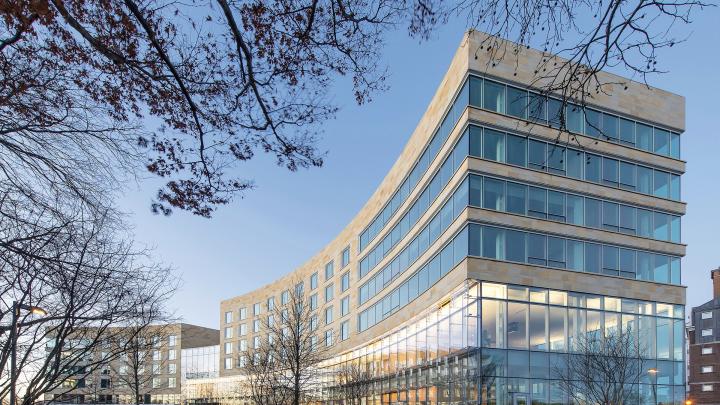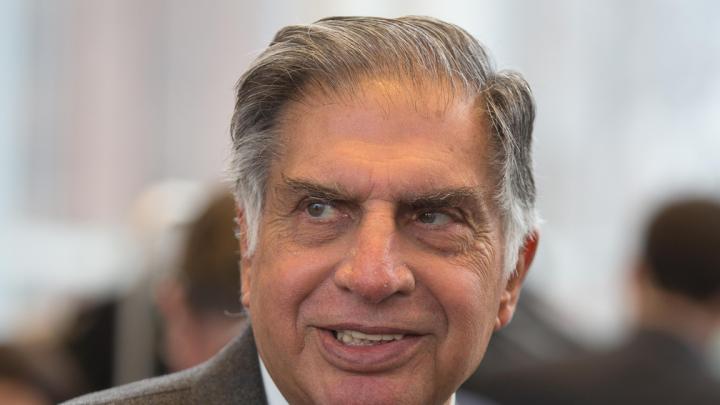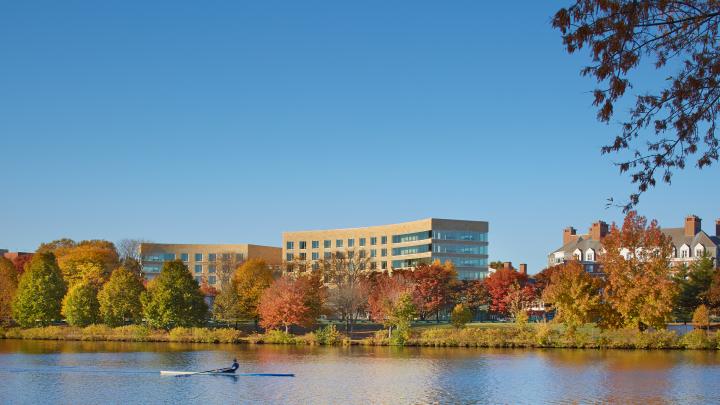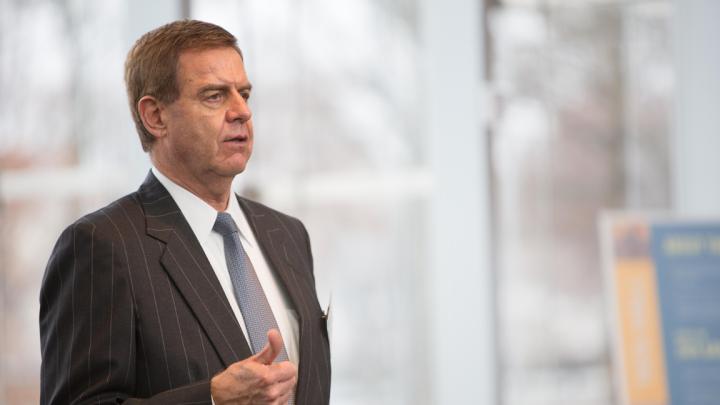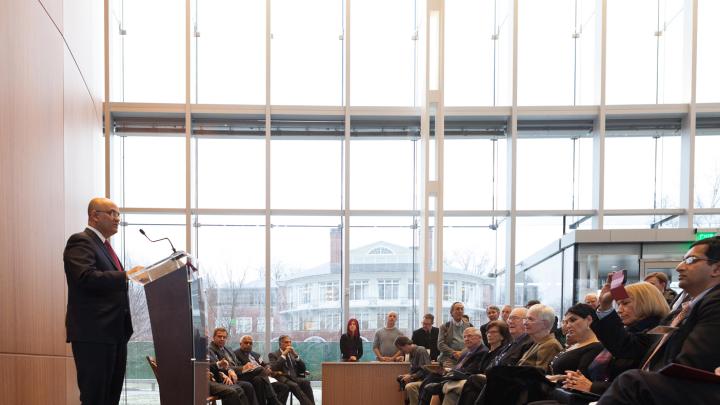Nearly 10,000 executives attend on-campus educational programs at Harvard Business School (HBS) each year, and many of them will be living and learning in Tata Hall, dedicated in a ceremony on December 9. The sweeping, concave, seven-story glass and stone building was underwritten by Ratan Tata, who attended the Advanced Management Program at HBS in 1975 and has worked closely with the school on executive education for many years. “Those 13 weeks were the most important time of my life in the way they transformed me and increased my perspective,” said Tata at the dedication. (He chaired the Indian conglomerate Tata Sons Ltd. from 1991 until his retirement last year, and in 1995 received HBS’s highest honor, the Alumni Achievement Award.)
In his remarks, HBS dean Nitin Nohria observed that Tata’s donation for the hall represented “by far, the most significant gift [to HBS] by an international alumnus” and by a graduate of an executive-education program. He noted as well that far more students participate in executive education than in degree-granting studies at the school, and that executive education “is every bit as important as our M.B.A. program.”
The architects of the new $100-million structure are William Rawn Associates. “As architects, this is the first time we have designed a building where the donor is a trained architect,” said its founder, William Rawn, J.D. ’69, at the dedication, adding, “That probably says more about the economics of the architecture profession than anything else,” to laughter from hundreds in attendance. (Tata earned a degree in architecture from Cornell in 1962.) More seriously, Rawn observed that the goal was to make the building “as warm and welcoming a place as possible” and to provide “transparency and openness.” The towering 37-foot-tall glass atrium of the entryway and large, operable windows in the 179 bedroom suites (many with superb views of the Charles River) help accomplish the latter objective. (For a profile of Rawn, see this 2012 feature in Harvard Magazine.)
Sustainability was a central concern in the design. Those glass walls have a double-skinned construction, with their two layers set 36 inches apart; the enclosed air becomes a thermal blanket in cold weather, and offers cooling convection in summer months. Initiatives include a rooftop electricity-generating photovoltaic array that contributes to an overall reduction of 50 percent in energy consumption and 40 percent in greenhouse gases; system HVAC choices like individualized control of heating and cooling—offering the option, for example, of not heating unoccupied units—make a large contribution to this outcome. Other design choices reduce water consumption by 900,000 gallons a year. Tata Hall is on track for LEED’s highest level (platinum) certification for its overall sustainability—a rating, Rawn noted, “quite rare in our culture.”
The 161,000 square-foot structure has two classrooms, one each on its first and second floors, each seating 99 students in the Business School’s trademark amphitheater style. On the upper floors, student bedrooms, each with private bath, are organized into eight-suite clusters; each cluster has access to a shared study lounge for both informal gathering and small-scale pedagogy. HBS chooses the residents of each cluster with an eye toward diversity in industries, geographic regions, and functional backgrounds.
The siting of Tata Hall, in one of the last remaining choice locations on the Charles River, was central to its success as a building. In a short presentation after the dedication ceremony, Rawn and his colleagues explained that they began with the 1927 plan that McKim, Mead & White drew up for the HBS campus, with its radial organization and buildings sited in a graceful concave arc facing the Charles River. The lines of Tata Hall also open in receptive concavity to the world beyond the school’s campus; to have made them convex, Rawn explained, “would have formed a real wall, a barrier.” The abundant glass on the lower stories permits vision, into, out of, and through the building. The location provides ready access to a pedestrian overpass above Storrow Drive that gives directly onto the Weeks Bridge, taking walkers across the Charles to Cambridge. Tata’s outdoor plan also incorporates three landscape areas that, said Rawn, “give back some of the grass we were taking away.”
Tata Hall completes the Business School’s Executive Education Quad, which also includes the residential halls McArthur, Baker (about to be renovated), and Mellon, the classroom buildings McCollum and Hawes Hall, the Kresge dining hall (about to be replaced), and the Glass Hall administration building. C.D. “Dick” Spangler Jr., M.B.A. ’56, LL.D. ’13, another generous HBS alumnus (M.B.A. students dine at Spangler Hall), called Tata “a tangible, graceful, useful building. When leaders from around the world get together and talk about important matters in Tata Hall, that is a force for peace and prosperity.” The global nature of HBS education was, in fact, a consistent theme of remarks at the dedication. Former Business School dean Jay Light, for one, emphasized that it will be “largely a global group of executives who will come to Boston and live in this building.” He was generous with praise for the structure itself, but added that “the best thing about this building is [its] name”—reminding people that Harvard Business School “is no longer a Boston institution, or a national institution, but a global institution. The Tata name is a global symbol of responsible, ethical business leadership. Our hope is that all that goes on within this building will live up to the name on that wall.”
